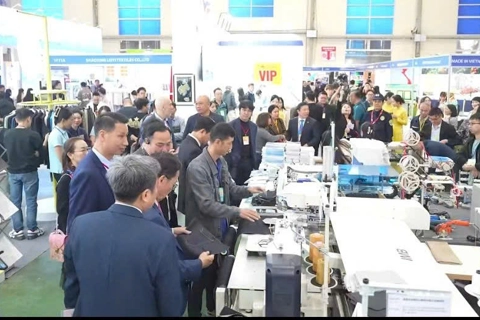Hanoi overachieves vocational training and job placement targets
Hanoi's vocational training enrollment results for 2020-2023 are 6.14% over target.
The proportion of trained workers in Hanoi has been continuously increasing every year, making an important contribution to providing trained workers for the labor market in the city and surrounding provinces, according to the latest report by Deputy Chairwoman of the Hanoi People's Committee Vu Thu Ha on the results of vocational training and job placement in the city from 2020 to the present.
| An overview of the 17th session of the Hanoi People's Council. Photos: Thanh Hai |
According to the report, the share of educated workers increased from 70.2% in 2020 to 73.2% in 2023 (an almost 3% increase). Of these, the proportion of workers with diplomas or certificates rose from 48.5% in 2020 to 52.5% in 2023 (up 4%). By 2023, the city's share of trained workers was 5.23 percentage points higher than the national average, and its share of workers with diplomas or certificates was 25 percentage points higher than the national average.
The Vice Chairwoman added that the quality of vocational training in the city has been increasingly validated and enhanced. The city's "Labor Training Index" in the Provincial Competitiveness Index scorecard has been highly valued by enterprises, with Hanoi ranking first in this category twice in the 2020-2023 period.
The city has found jobs for more than 900,000 people, an increase of 23% from 2016 to 2019. This includes nearly 230,000 people hired with VND8.95 trillion (US$348 million) in aid disbursed through the Hanoi branch of the Vietnam Bank for Social Policies. In addition, the city has sent 15,600 workers on contract to work abroad and provided vocational training for nearly 2,800 jobless beneficiaries of unemployment insurance with a budget of VND7.1 billion (US$276,434).
By 2023, Hanoi's job placement accounted for around 31% of the national total. The city's unemployment rate among the working-age population was 2%, 0.27 percentage points lower than the national average. The unemployment rate in urban areas was nearly 3%, and in rural areas it was 1%.
The Vice Chairwoman also pointed out some shortcomings, such as most high school graduates want to go to university rather than pursue vocational training. Meanwhile, there are many universities in the city with large enrollment quotas and relatively low selection criteria, leaving vocational schools with insufficient admissions.
She added that many companies recruiting on job boards are primarily looking for unskilled workers, while the local workforce is more likely to apply for higher-skilled positions.
The overemphasis on higher education and the mismatch between employer needs and worker aspirations are challenges that the city must address to develop a more balanced and responsive workforce ecosystem.
Currently, the maximum level of support provided by the central government is lower than the actual cost of the training service, requiring the learner to cover the difference, which poses significant difficulties for beneficiaries under Prime Ministerial Decision No. 46/2015/QD-TTg of September 28, 2015.
Local employment service providers have not yet established strong coordination and linkages with the Hanoi Center for Employment Service, satellite job exchange platforms, and other channels to better assist job seekers and businesses with hiring needs, especially in supporting job placement for people with disabilities.
"The labor database is still incomplete and not shared. The use of information technology in analyzing, forecasting, and aggregating labor demand is restricted. There is no management software for online interviewing, data storage, job counseling and placement, vocational training, and unemployment insurance," she said. "As a result, there are no timely and accurate tools for assessing labor supply and forecasting employment needs in the labor market."
| Vice Chairwoman of the Hanoi People's Committee Vu Thu Ha speaks at the session. |
To address these limitations, the city will enhance coordination among relevant stakeholders, invest in digital infrastructure, and develop data-driven solutions to better match workforce supply and demand, she underlined.
The Vice Chairwoman also said that in the period ahead, the city will continue to review and improve the quality of vocational training institutions in conformity with the city's human resources development plans and the 2021-2030 vocational training network planning.
Hanoi will also intensify the dissemination of the city's governing documents on human resource development and job placement through the information systems of the districts and towns.
In addition, the city will match vocational institutions with employment services, job platforms, job fairs, and business incubators. This will help graduates find jobs and link training to overseas worker placement.
To ensure that vocational training conforms to actual market demand, the department is continuing to coordinate with districts and towns to propose updates to the list of 78 occupations, including deleting 14 occupations and adding 15 new ones, said Director of Hanoi Department of Labor, Invalids and Social Affairs Bach Lien Huong at the interpellation session on employment issues in Hanoi on July 3.
|













